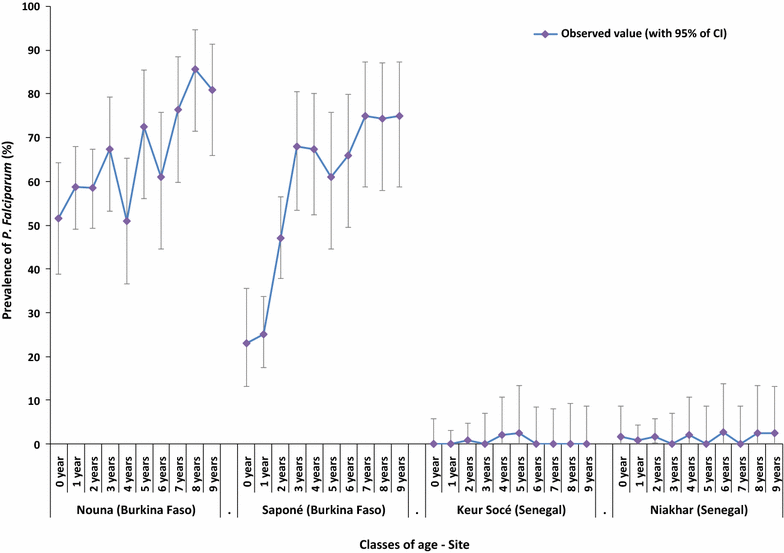An epidemiological study to assess Plasmodium falciparum parasite prevalence and malaria control measures in Burkina Faso and Senegal
- PMID: 28166794
- PMCID: PMC5294715
- DOI: 10.1186/s12936-017-1715-1
An epidemiological study to assess Plasmodium falciparum parasite prevalence and malaria control measures in Burkina Faso and Senegal
Abstract
Background: Malariometric information is needed to decide how to introduce malaria vaccines and evaluate their impact in sub-Saharan African countries.
Methods: This cross-sectional study (NCT01954264) was conducted between October and November, 2013, corresponding to the high malaria transmission season, in four sites with Health and Demographic Surveillance Systems (DSS) [two sites with moderate-to-high malaria endemicity in Burkina Faso (Nouna and Saponé) and two sites with low malaria endemicity in Senegal (Keur Socé and Niakhar)]. Children (N = 2421) were randomly selected from the DSS lists of the study sites and were stratified into two age groups (6 months-4 years and 5-9 years). A blood sample was collected from each child to evaluate parasite prevalence of Plasmodium falciparum and other Plasmodium species and gametocyte density by microscopy, and rapid diagnosis test in the event of fever within 24 h. Case report forms were used to evaluate malaria control measures and other factors.
Results: Plasmodium falciparum was identified in 707 (29.2%) children, with a higher prevalence in Burkina Faso than Senegal (57.5 vs 0.9% of children). In Burkina Faso, prevalence was 57.7% in Nouna and 41.9% in Saponé in the 6 months-4 years age group, and 75.4% in Nouna and 70.1% in Saponé in the 5-9 years age group. Infections with other Plasmodium species were rare and only detected in Burkina Faso. While mosquito nets were used by 88.6-97.0 and 64.7-80.2% of children in Burkina Faso and Senegal, other malaria control measures evaluated at individual level were uncommon. In Burkina Faso, exploratory analyses suggested that use of malaria treatment or any other medication within 14 days, and use of insecticide spray within 7 days decreased the prevalence of malaria infection; older age, rural residence, natural floor, grass/palm roof, and unavailability of electricity in the house were factors associated with increased malaria occurrence.
Conclusions: Plasmodium falciparum infection prevalence in children younger than 10 years was 57.5% in Burkina Faso and 0.9% in Senegal, and variability was observed, among others, by age, study site and malaria control measures.
Keywords: Burkina Faso; Epidemiological study; Malaria; Parasite prevalence; Preventive interventions; Risk factors; Senegal.
Figures


References
-
- WHO Malaria vaccine: WHO position paper. Wkly Epidemiol Rec. 2016;91:33–51. - PubMed
-
- WHO. World malaria report. Geneva: World Health Organization; 2014. http://www.who.int/malaria/publications/world_malaria_report_2014/report.... Accessed 23 May 2016.
-
- Meeting of the Strategic Advisory Group of Experts on Immunization Conclusions and recommendations. Wkly Epidemiol Rec. 2015;2015(90):681–699. - PubMed
-
- The RTS,S Clinical Trials Partnership Efficacy and safety of the RTS, S/AS01 malaria vaccine during 18 months after vaccination: a phase 3 randomized, controlled trial in children and young infants at 11 African sites. PLoS Med. 2014;11:e1001685. doi: 10.1371/journal.pmed.1001685. - DOI - PMC - PubMed
Publication types
MeSH terms
Associated data
LinkOut - more resources
Full Text Sources
Other Literature Sources
Medical

